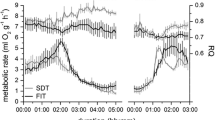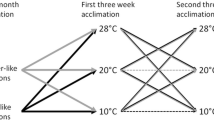Summary
In Phodopus sungorus spontaneous shallow daily torpor occurred only during winter. Frequency of torpor was not affected by low ambient temperature but the seasonal cueing seems primarily dependent on photoperiodic control. Maximum torpor frequency was found in January with 30% of all hamsters living inside or outside being torpid at a time. It is calculated that torpor will reduce long term energy requirements of Phodopus by only 5%. Therefore it is concluded that torpor is not primarily aimed to reduce energy requirements but to guarantee survival of a fraction of a population during short periods of extreme cold load or inaccessability of food.
Similar content being viewed by others
References
Figala J, Hoffmann K, Goldau G (1973) Zur Jahresperiodik beim Dsungarischen Zwerghamster, Phodopus sungorus, Pallas. Oecologia (Berl) 12:89–118
Gaertner RA, Hart JS, Roy OZ (1973) Seasonal spontaneous torpor in the white-footed mouse, Peromyscus leucopus. Comp Biochem Physiol 45A:169–181
Heldmaier G, Steinlechner S (in press) Seasonal control of energy requirements for thermoregulation in the Djungarian hamster (Phodopus sungorus), living in natural photoperiod. J comp Physiol
Hill RW (1975) Daily torpor in Peromyscus leucopus on an adequate diet. Comp Biochem Physiol 51A:413–423
Hoffmann K (1973) The influence of photoperiod and melatonin on testis size, body weight, and pelage colour in the Djungarian hamster (Phodopus sungorus). J comp Physiol 85:267–282
Hudson JW (1973) Torpidity in mammals. In: Comparative Physiology of thermoregulation, Vol III, GC Whittow (ed), New York London, p 98–158
Hudson JW (1978) Shallow daily torpor: a thermoregulatory adaptation. In: LCH Wang, JW Hudson (ed), Strategies in cold. Academic Press, New York San Francisco London, p 67–108
Hudson JW, Scott IM (1979) Daily torpor in the laboratory mouse, Mus musculus var. albino. Physiol Zool 52:205–218
Lynch GR, White SE, Grundel R, Berger MS (1978a) Effects of photoperiod, melatonin administration and thyroid block on spontaneous daily torpor and temperature regulation in the white-footed mouse, Peromyscus leucopus. J comp Physiol 125:157–163
Lynch GR, Vogt FD, Smith HR (1978b) Seasonal study of spontaneous daily torpor in the white-footed mouse, Peromyscus leucopus. Physiol Zool 51:289–299
Tucker VA (1965a) Oxygen consumption, thermal conductance, and torpor in the California pocket mouse, Perognathus californicus. J Cell Comp Physiol 65:393–404
Tucker VA (1965b) The relation between the torpor cycle and heat exchange in the California pocket mouse, Perognathus californicus. J Cell Comp Physiol 65:405–414
Wang LCH (1978) Energetic and field aspects of mammalian torpor: the Richardson's ground squirrel. In: LCH Wang, JW Hudson (ed) Strategies in cold. Academic Press, New York San Francisco London, p 109–145
Author information
Authors and Affiliations
Additional information
Supported by the Deutsche Forschungsgemeinschaft (He 990). Expert technical assistance of P. Hebblethwaite is gratefully acknowledged
Rights and permissions
About this article
Cite this article
Heldmaier, G., Steinlechner, S. Seasonal pattern and energetics of short daily torpor in the Djungarian hamster, Phodopus sungorus . Oecologia 48, 265–270 (1981). https://doi.org/10.1007/BF00347975
Received:
Issue Date:
DOI: https://doi.org/10.1007/BF00347975




